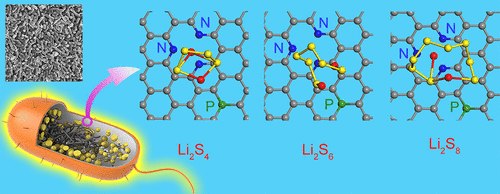Publications
Bacteria Derived Biological Carbon Building Robust Li-S Batteries
Tao Wang, Jian Zhu, Zengxi Wei, Hongguan Yang, Zhaolin Ma, Ruifang Ma, Jian Zhou, Yuhua Yang, Lele Peng, Huilong Fei, Bingan Lu, Xiangfeng Duan
Nano Lett. 19, 4384-4390 (2019)

Lithium sulfur (Li–S) batteries are attracting increasing interest for high-density energy storage. However, the practical application is limited by the rapid capacity fading over repeated charge/discharge cycles which is largely attributed to the formation and shuttling of soluble polysulfide species. To address these issues, we develop a hierarchical structure composite with triple protection strategy via graphene, organic conductor PEDOT, and nitrogen and phosphorus codoped biological carbon to encapsulate sulfur species (GOC@NPBCS). This unique hierarchical structure can effectively immobilize the sulfur species while at the same time improve the electrical conductivity and ensure efficient lithium ion transport to enable excellent Li–S battery performance. In particular, the biological carbon derived from natural bacteria features inherent nitrogen and phosphorus codoping with a strong absorption to lithium polysulfides, which can greatly suppress the dissolution and shuttling of polysulfides that are responsible for rapid capacity fading. With these synergistic effects, the GOC@NPBCS cathode exhibits exceptionally stable cycling stability (an ultralow capacity fading rate of 0.045% per cycle during 1000 cycles at the current rate of 5 C), high specific capacity (1193.8 mAh g–1 at 0.5 C based on sulfur weight), and excellent rate capability.
UCLA, Department of Chemistry and Biochemistry
607 Charles E. Young Drive East, Box 951569
Los Angeles, CA 90095-1569
E-mail: xduan@chem.ucla.edu
607 Charles E. Young Drive East, Box 951569
Los Angeles, CA 90095-1569
E-mail: xduan@chem.ucla.edu







